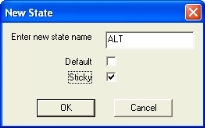
Using key states, you can create many different actions for each mobile device key. For example, you can configure a key to send "a" in the normal state and "A" in a CAPS LOCK state. This allows multiple uses for the same keys.
You also have the option of making each key a multi‑click key. This means that in one state, a key can perform up to four different actions depending on the number of times it is pressed.
Each state can be defined as a sticky state. When a state is sticky, it will persist until the user changes the state again. If the state is not set to be sticky, then after another key is pressed, the device will be reset to the default state. (For example, CAPS LOCK is a sticky state that persists until the user switches the state. SHIFT normally changes the state until a key is pressed and then the device goes back to the default state.)
To create new device states:
1 In the Actions Editor area, click New.
The New State dialog box appears.
2 Enter a name for the state.
3 Enable the Default option if you want this state to be the default state the keys are in when displayed in the Standard Viewer.
4 Enable the Sticky option if you want this state to be sticky.
5 Click OK when you are finished.
The new state appears as a tab in the Actions Editor area.
Was this article useful?
The topic was:
Inaccurate
Incomplete
Not what I expected
Other